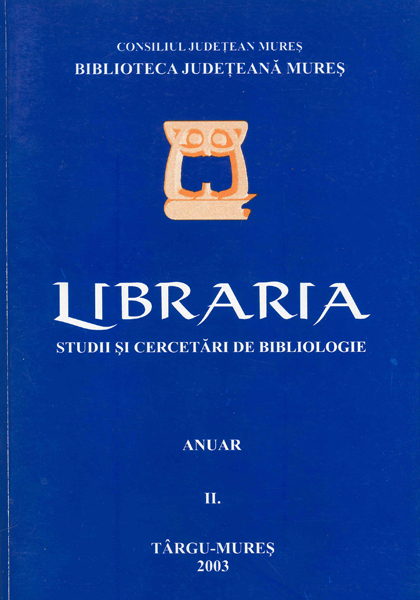Cartea franceză de matematică din epoca Renaşterii în colecţiile Bibliotecii Academice Clujene
French Mathematics Books from the Age of Renaissance in the Collections of Biblioteca Academică Clujeană
old book
Author(s): Elena DamianSubject(s): Museology & Heritage Studies, Library and Information Science, Other
Published by: Biblioteca Județeană Mureș
Keywords: Libraria; Biblioteca Județeană Mureș; biblioteconomie; bibliologie; carte veche; carte bibliofilă; istorie locală; servicii de bibliotecă; Biblioteca Teleki; carte veche românească;
Summary/Abstract: Renaissance represented a new age of intelectual development and the evolution of printing art during the 16th century allowed book diffusion. The editorial production of the period is represented by numerous humanistic and scientific works.A very important contribution in book diffusion belongs to Francisc the 1st, also known as “The King of Renaissance”. In 1539 he signed a document that encouraged the use of French in juristic acts and also in written culture.During the 16th century, the evolution of mathematical sciences took place inside of the so-called “schools”: the Italian school, the German one and the French one. Up to the age of François Viète, who’ s works became known only in the 17th century, the French maths school remained strictly connected to Italian and German book production.The diffusion of French maths books ows a lot to Jacques Lefèvre d’Etaples. He published at Paris several editions from Boethius’ s Aritmetica and Jordanus Nemoriarus’ s Aritmetica. He also published Sacroboso’ s Sfera and was interested in publishing Cusanus’ s Opera Omnia. Oronce Finé (1494-1555), the first titular professor of mathematics at the Royal College, wrote numerous mathematics and astronomy books; the best known is Protomethis (Fundamentele matematicii), printed at Paris in 1532.Biblioteca Academică Clujeană keeps a copy of Gemma Frisius’ s work Arithmeticae practicae methodus facilis per Gemmam Frisium, medicum ac mathematic , iam recens, ab ipso authore emendata et multis in locis insigniter aucta. Huc accesserunt Jacobi Peletarii Cenomani annotationes: Eiusdem item de Fractionibus Astronomicis compendium: Et de cognoscendis per memoriam Calendis, Idib. Nonis, Festis mobilibus, et loco Solis et Lunae in Zodiaco. Coloniae, Apud Maternum Cholinum, published in 1564; it contains 221 pages and is covers are made of leather.But there is also another copy of this work, published in 1581. The title is a little modified: Arithmeticae practicae methodus facilis per Gemmam Frisium, medicum ac Mathematicum conscripta; iam recens ab Auctore pluribus locis aucta et recognita. In eandem Ioannis Steinii et Jacobi Peletarii Annotationes. Eiusdem de Fractionibus Astronomicis. Compendium et de cognoscendis per memoriã Kalendis, Idibus, Nonis, Festis mobilibus, locoq Solis et Lune in Zodiaco. Antverpiae, Apud Ioannem Bellerum ad insigne Aquilae aureae.Pierre de la Ramée (1515-1572) is represented by 35 of his works. His ideas are comprised in a large work: Scholarum mathematicarum libri XXXI, printed at Basel in 1569. Among the works published during the age of Renaissance, Biblioteca Academică Clujeană keeps 7 copies from: Scholarum mathematicarum libri XXXI. À Lazaro Schonero recogniti et emendati.Francofurti, apud Andreae Wecheli haeredes Claudium Marnium et Ioannem Aubrium (1599); Arithmetices libri duo et algebrae totidem: à Lazaro Schonero emendati et explicati. Francofurdi, apud heredes Andreae Wecheli (1586); Arithmetices libri duo et algebrae totidem: à Lazaro Schonero emendati et explicati. Francofurdi, apud heredes Andreae Wecheli, (1586). It is worth mentioning his translation into French of fragments from euclidian mathematics.At his turn, Jacques Besson (1510-1576) edited a large number of mathematic treaties. One of them, Theatrum instrumentorum et machinarum. Jacobi Bessoni Delphinatis Mathematicii ingeniosissimi. Cum Franc. Beroaldi Figurarum declaratione demonstrativa. Lug duni, apud Barth Vincentium is kept at Cluj.François Viète is considered to be one of the most important mathematicians of his age; during his activity, at Paris, he had an important role in setting up the scientific methods of work. His best known work, In artem analyticam isagoge (Introducere în arta calculului), was published after his death, in 1646.We may conclude that the French mathematicians are very well represented by their works at Biblioteca Academică Clujeană.
Journal: Libraria. Studii și cercetări de bibliologie
- Issue Year: II/2003
- Issue No: 2
- Page Range: 176-184
- Page Count: 9
- Language: Romanian

